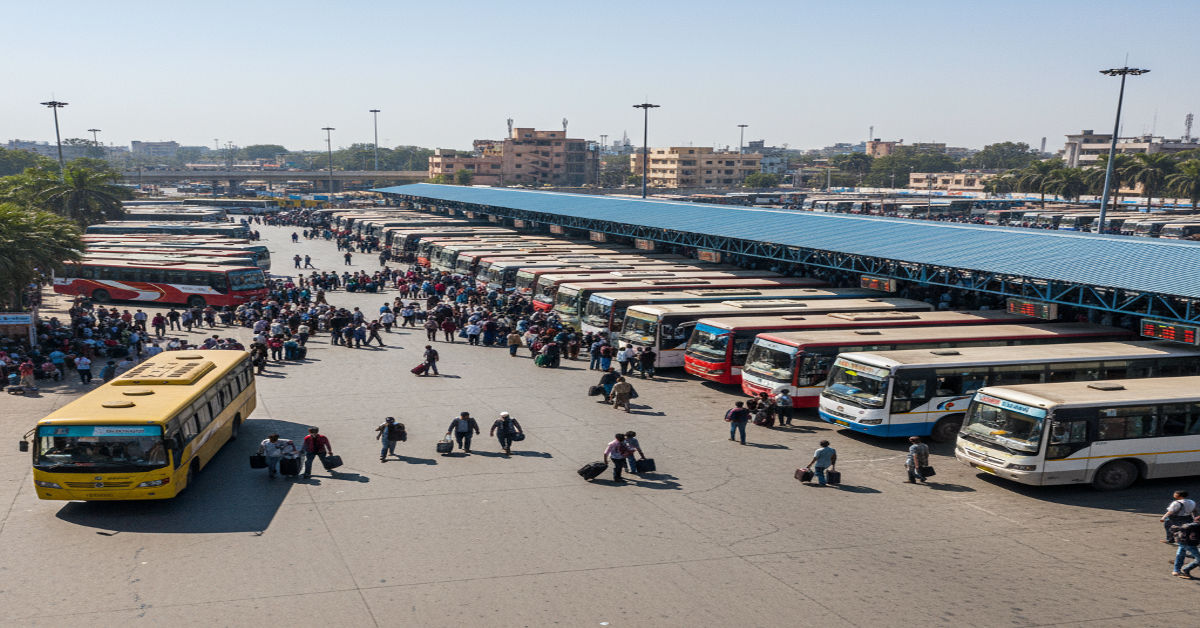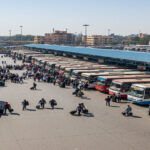At the heart of Pune, where old neighborhoods meet the expanding arteries of a modern city, stands a place that has quietly shaped millions of daily journeys — the Shivajinagar Bus Stop. For decades, it has been more than a transport hub; it has been a civic landmark, a meeting ground, and a witness to the city’s changing tempo. From students catching the first bus to Ahmednagar to factory workers heading home at dusk, its platforms have carried the rhythm of Pune’s working life.
Today, that rhythm sounds different. The historic bus stop — once the principal depot for the Maharashtra State Road Transport Corporation (MSRTC) and countless private operators — is in the midst of a transformation. Its relocation to a temporary site during the construction of Pune Metro has stirred debate about access, urban planning, and the delicate balance between progress and public convenience.
The redevelopment plan envisions a multi-modal transit hub that will connect buses, metro, and trains through a single integrated system. Yet, in this interim period, commuters find themselves juggling higher travel costs, longer walking distances and a sense of dislocation from the city’s core.
Understanding the story of Shivajinagar Bus Stop means understanding how India’s cities evolve — through tension between old and new, tradition and innovation. It is a story that touches infrastructure, commerce, governance, and everyday life. This piece brings together expert voices, field observation, and civic insight to unpack the bus stop’s past, its uncertain present, and its ambitious future.
The History of a City’s Artery
The Shivajinagar Bus Stop traces its origins to the late 1940s, when post-Independence Maharashtra sought to connect its growing towns through state-run road transport. Strategically located near the railway station and central colleges, it became Pune’s gateway to the rest of the state. Over time, its platforms filled with the hum of diesel engines, snack vendors, and the chatter of travelers leaving for Mumbai, Nashik, and beyond.
By the early 2000s, the stand was serving tens of thousands daily. Yet its aging infrastructure struggled to cope with urban expansion. The arrival of the Pune Metro presented both challenge and opportunity — a chance to modernize, but at the cost of temporary displacement.
As bulldozers cleared space for tunneling, the Shivajinagar stop was reduced to a memory wrapped in blue tin sheets, waiting for its reincarnation.
Urban Relocation and Its Ripples
Relocating a central transport hub is like rerouting a bloodstream. When the MSRTC operations shifted to Wakdewadi, the ripple effects were immediate. Commuters found themselves negotiating traffic snarls, fewer municipal bus connections, and unfamiliar surroundings.
Local merchants around the old depot reported revenue losses of up to 40 percent. Nearby cafés that once thrived on steady passenger traffic faced sudden quiet. Meanwhile, the new site struggled with congestion, limited restrooms, and inadequate shade — discomfort magnified during Pune’s humid summers.
Urban planners defend the relocation as a necessary interlude before progress. Yet, for those navigating daily chaos, patience wears thin. “We’re told it’s temporary,” says Ritesh Patil, an insurance agent who commutes to Nashik weekly, “but temporary has lasted years.” The sentiment captures a larger truth: infrastructure gaps erode civic trust long before new projects heal them.
The Promise of a Multi-Modal Future
Plans for a state-of-the-art Shivajinagar terminal read like a blueprint for modern India’s transit ambitions. The proposed design integrates bus bays, a metro link, and pedestrian bridges to the nearby railway station. It envisions ticketless entry, real-time tracking displays, and commercial floors above the concourse — cafés, bookstores, co-working pods.
Officials argue that the redevelopment follows a Transit-Oriented Development (TOD) model, which seeks to merge mobility and commerce. It’s a formula seen in Tokyo and Singapore, now arriving in Pune’s backyard.
For the government, the hub is a demonstration of economic self-sufficiency: transport revenue supplemented by retail leasing. For commuters, the hope is simpler — shorter queues, cleaner restrooms, and fewer missed connections. The tension between ambition and execution remains, but the vision signals that India’s transport is thinking beyond asphalt and timetables.
Economic Pulse of the Neighborhood
Before its relocation, the Shivajinagar depot supported an informal economy of remarkable density — tea vendors, luggage porters, mechanics, photocopy stalls, and mobile-charger kiosks. Together, they represented a network of livelihoods tied to bus schedules.
When the terminus moved, many of these micro-businesses vanished overnight. Some relocated near Wakdewadi; others shut down entirely. “I lost half my customers when the buses left,” says Shanta Kadam, who sold vada pav outside Gate 3 for twenty years.
Economists often speak of infrastructure in terms of productivity, but for small entrepreneurs, it is survival. The new hub, with its glass facades and digital kiosks, promises opportunity — but also raises questions about inclusion. Will the vendors who kept the old stand alive find a place in the new order, or will modernization price them out?
Timeline of Shivajinagar Bus Stop
| Year | Event | Impact |
| 1948 | Launch of first state-run intercity buses from Pune | Birth of regional connectivity |
| 1970s–2000s | Shivajinagar emerges as principal MSRTC terminus | Peak commuter volume |
| 2019 | Relocation to Wakdewadi for metro construction | Access disruption, business losses |
| 2024 (onward) | Approval for modern multi-modal hub | Anticipated revival and urban renewal |
Technology, Mobility and the Digital Shift
Even as physical infrastructure lagged, Pune’s commuters embraced digital tools. Platforms such as RedBus and government apps now handle most bookings, showing dozens of daily departures from Shivajinagar and Wakdewadi combined. The migration to online ticketing softened some of the disruption: fewer queues, more transparency.
Yet the contrast between digital efficiency and physical inconvenience highlights a paradox of modern India — connectivity without comfort. Bus passengers track schedules on smartphones while standing under leaky shelters.
In the upcoming terminal, authorities promise seamless integration: QR-based boarding, synchronized metro-bus passes, and smart navigation kiosks. If implemented, it could set a national standard for urban transport technology. But for commuters accustomed to glitches and delays, optimism remains cautious.
Voices from the Street
Outside the temporary terminus on a cloudy afternoon, drivers and passengers exchange resigned smiles. “This used to be simpler,” says Abdul Shaikh, a long-distance driver who has plied the Pune–Nashik route for fifteen years. “Earlier, you parked, loaded passengers, and left. Now it takes half an hour just to exit.”
Nearby, students from the agriculture college wait under a shed patched with tarpaulin. One scrolls through a bus app, another balances a backpack as vehicles honk incessantly. “We just want proper signage and shade,” one remarks, “not luxury.”
Their words echo the essence of commuter dignity — a small comfort that often defines the experience of public transport. For all the talk of smart cities, the basic needs of travelers remain profoundly human: clarity, safety, and rest.
Urban Planners’ Dilemma
Shivajinagar’s redevelopment exposes the contradictions of urban growth. On one hand, central land is scarce and valuable; integrating the metro and bus lines could yield long-term environmental and economic benefits. On the other, every day of delay costs citizens time and money.
City planner Priya Rahman describes it as a “balancing act between mobility and memory.” She notes that infrastructure isn’t neutral — it shapes where people live, work, and socialize. When a terminal moves, so do invisible lines of community.
For planners, success will depend on inclusive design: accessible ramps, safe crossings, clear wayfinding, and affordable retail space. Without these, the new station risks becoming a monument to missed opportunity.
Comparative Overview
| Feature | Old Shivajinagar Stand | Temporary Wakdewadi Site | Planned Multi-Modal Hub |
| Location | Central, near civic core | 2 km north, limited access | Central, integrated with metro |
| Amenities | Basic, outdated | Minimal, makeshift | Modern lounges, restrooms, retail |
| Traffic Flow | Predictable | Congested | Redesigned for circulation |
| Economic Activity | Informal vendors | Fragmented | Formal commercial space |
| User Satisfaction | High nostalgia | Low convenience | Yet to be tested |
Commuter Psychology and Social Impact
Beyond economics, the Shivajinagar story is psychological. Daily travel routines anchor people’s sense of control and rhythm. When those routines are disrupted, frustration becomes collective. Behavioral economists note that perceived inconvenience often outweighs actual travel time in shaping satisfaction.
In interviews conducted over several weeks, commuters described feeling “disconnected” from their city’s center. For some, the extra fifteen minutes to Wakdewadi translates to lost study time or missed appointments. For others, it’s the absence of familiar faces — the tea vendor who knew their order, the guard who watched their bag.
This erosion of micro-relationships reveals how public infrastructure quietly binds social fabric. When redeveloped, the new hub must do more than move people efficiently; it must rebuild those small, human connections.
Governance, Finance and the Road Ahead
The success of the upcoming hub hinges on governance. Funding is expected through a public-private partnership, where commercial rents will help offset construction and maintenance costs. Officials argue that such models bring efficiency, but watchdogs warn against prioritizing profit over public service.
Accountability remains key. Transparent timelines, regular progress updates, and stakeholder consultation can transform skepticism into civic participation. Digital dashboards — already used in some Indian cities — could track project milestones in real time.
If managed well, the Shivajinagar redevelopment could demonstrate that modernization need not mean displacement. If mismanaged, it could deepen cynicism about “smart city” promises. The difference will rest not in concrete but in communication — whether authorities treat commuters as partners or statistics.
Five Key Takeaways
- Heritage meets modernity: Shivajinagar Bus Stop embodies Pune’s evolving identity — from colonial-era outpost to modern transit hub.
- Temporary dislocation: The shift to Wakdewadi disrupted thousands of commuters and small businesses, highlighting planning blind spots.
- Digital-physical gap: Online booking surged even as physical amenities lagged, underscoring uneven modernization.
- Economic regeneration: The new hub could revive local commerce if inclusion and affordability are prioritized.
- Governance test: Transparent execution and commuter engagement will decide whether progress feels participatory or imposed.
Conclusion
Standing on the pavement where the old depot once bustled, one feels both nostalgia and anticipation. The Shivajinagar Bus Stop is more than a waypoint on a map; it’s a mirror reflecting how cities grow — imperfectly, ambitiously, and sometimes painfully.
For the generations who watched its red buses depart into the night, its absence feels personal. Yet the vision ahead — a luminous, multi-level station humming with efficiency — offers hope that modern infrastructure can honor old routes.
When completed, the new Shivajinagar hub could become a symbol of balance: efficiency with empathy, progress with memory. But until that promise materializes, commuters will continue to navigate the city’s temporary detours — reminders that mobility is not merely about movement, but about belonging.
FAQs
1. Where is Shivajinagar Bus Stop located?
It lies in Pune’s Shivajinagar neighborhood, close to Ganeshkhind Road and the central railway station, connecting urban and intercity routes.
2. Why was it relocated?
Operations shifted to Wakdewadi to accommodate underground metro construction, with plans for a rebuilt multi-modal terminal on the original land.
3. What facilities will the new hub include?
Designs feature integrated metro access, air-conditioned lounges, digital ticketing, and commercial retail areas within the complex.
4. How has relocation affected commuters?
Many face higher last-mile costs, longer travel times, and reduced comfort, though online ticketing has improved convenience.
5. When will the new terminal open?
Construction and approvals are underway, but no final public opening date has been confirmed as of late 2025.







